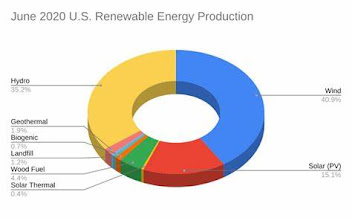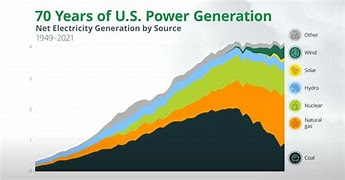Power in US and renewables (primarily for US audiences) (v1.0)
This subject is best written as a country specific essay.
Power generation in US today consumes a lot of
fossil fuels.
--------
Oahu, my home's, renewable experience is interesting. It shut down its last coal plant but has
traditionally relied heavily on petroleum for electric generation. Because this
must be shipped to the middle of the pacific and because of its isolated island grids, electric prices are high (32.47
cents per KWh). It has shifted a sizable portion of its generation to
renewables (31% to 33% of Oahu as well as Hawaii's electricity is from renewables). Tax benefits have encouraged a lot of homes
to add solar to their roofs also.
But there have been power blackouts on occasion. This may be because a lot of this power generation is susceptible to the vagaries of nature. This highlights the need for a mix of power sources that include sources not susceptible to the vagaries of nature like waste to energy, biodiesel and biofuel. The big island also gets some of its power from geothermal. Unfortunately, Hydroelectric is not really an option because there are no decent rivers on Oahu. Hawaii has also invested early in battery-based Grid energy storage which stabilizes the Grid and enhances Grid reliability and resilience. It is also looking at grid modernization strategy including smart grid.
The key focus of Hawaii is the three R’s. reliability (light comes on when you turn on the switch), Reasonable (price should be acceptable to the market), and Renewable. I believe the price will come down as more and more electricity is generated from renewables. Hawaii has a goal of 100% electricity from renewables and is making steady progress. Also, the rate at which the transition occurs should be carefully planned.
So, the key principles for renewable success are:
- The three R’s
- The power source Mix
- The transition rate.
- Grid storage.
--------
Other states aggressively pursuing renewables are CA, TX, ID, WA, SD, VT, OR, ME. Both Texas and California are expanding the most rapidly in solar and storage.
Let us look
at the 2022 statistics of these states.
Vermont:
99.6% from renewables. 2.2 TWh.
South
Dakota: 81.4% from renewables. 14.6 TWh.
Washington:
75.7% from renewables. 88.4 TWh.
Idaho: 73%
from renewables. 11.9 TWh.
Hawaii: 33%
from renewables. 1.8 TWh.
California:
43% from renewables. 87.4 TWh.
Texas: 26.5%
from renewables. 139.3 TWh.
Oregon:
68.9% from renewables. 42.2 TWh.
Iowa: 64.9%
from renewables. 47.4 TWh.
Maine: 62.9%
from renewables. 8 TWh.
In total
these states together generate about 25% of all US electricity, and 50% of all
renewables.
Avg cost of
electricity in US is about 15.45 cents per KWh.
Avg cost of
electricity in SD is about 12.37 cents per KWh.
Avg cost of electricity in Vermont is about 21.12 cents per KWh (I think primarily because the utilities are tightly regulated).
Where a State/Territory is currently, depends a lot on where they started from, and the state policies adopted.
Renewable Portfolio Standards (RPS) require that a specified percentage of the electricity utilities sell comes from renewable resources. States have created these standards to diversify their energy resources, promote domestic energy production and encourage economic development.
Renewable energy policies help drive the nation’s $269 billion market as of 2022, for wind, solar and other renewable energy sources. These policies can play an integral role in state efforts to diversify their energy mix, promote economic development and reduce emissions. Roughly half of the growth in U.S. renewable energy generation since the beginning of the 2000s can be attributed to state renewable energy policies.
The states and territories with renewable portfolio standards are HI, WA, OR, CA, TX, ME, VT, NV, AZ, CO, NM, MN, IL, MO, MI, OH, MD, VA, PA, DE, NJ, NY, DC, CT, MA, NH, RI, PR, VI.
The states and territories with voluntary renewable energy standards and targets are UT, IN, SC, GU.
The states and territories with expired goals are ND, WI, SD, IA, KS, OK, MP. (does not mean they don't have renewable efforts!)
The states and territories without any are AK, MT, ID, WY, NE, KY, WV, AR, TN, LA, MS, AL, GA, FL, AS. (does not mean they don't have renewable efforts!)
--------
--------
Nuclear Fusion seems far off, but I don't think people should rule out new nuclear fission plants out of hand despite some definite negatives to them (like the possibility of a Fukushima like disaster and disposal of radioactive wastes). These are like renewables since no greenhouse gas is emitted and is considered clean energy. It is provided by 92 commercial reactors with a net capacity of 94.7 GW, with 61 pressurized water reactors. In 2019, they produced a total of 809.41 terawatt-hours of electricity, which accounted for 20% of the nation's total electric energy generation. In 2018, nuclear comprised nearly 50 percent of US emission-free energy generation. In 2024 generation is on average 65 terawatt-hours per month. But nuclear is expensive to operate and build so must be judicious about where and when to deploy it, and when to crank it up, operate at reduced capacity, or operate at full capacity. But nuclear can be very good for baseload electricity.
I read this today Jun 9, 2024 - "The White House on Wednesday plans to announce new measures to support the development of new U.S. nuclear power plants, a large potential source of carbon-free electricity the government says is needed to combat climate change.". This was coupled with the biggest clean energy bill, to go on a nuclear power spree, which just passed, ending decades of inactivity there.
States/Territories that have committed to 100% clean energy are: CA, CO, CT, DE, HI, IL, LA, ME, MD, MA, MI, MN, NE, NV, NJ, NM, NY, NC, OR, PR, DC, RI, VA, WA, and WI.
In 2022, 40.6% of the US electricity mix came from clean energy sources, marking an all-time high. This includes wind, hydroelectric, and solar power, as well as nuclear (which is not renewable but emits no greenhouse gases and is clean energy). While natural gas remained the largest source of electricity, contributing 39.4%, coal-fired generation fell to 19.4%. Wind led the way among renewables, followed by hydroelectric power and solar power. Additionally in 2020, the US generated 834 million megawatt hours of electricity from renewables, making it a record year for green energy.
Here are three useful charts.
For climate mitigation, I think states have one of four choices.
- Throttle demand with price increases but then inflation may pick up.
- Throttle demand with regulation but then the economy may be smothered.
- Invest in almost all electricity to come from renewables or clean sources which has no or low carbon footprint.
- Allow some nonclean energy and hope to offset it.
You could consider installing rooftop solar. Grassroot support makes it easier for state government to roll out renewables. In the future, if not almost fully powered with renewables or clean energy in your state, and the carbon sinks allocated and carbon credits purchased by your state are not enough to offset emissions, you can cut demand.






Comments
Post a Comment